
Eriogonum alpinum is a species of wild buckwheat known by the common name Trinity buckwheat.
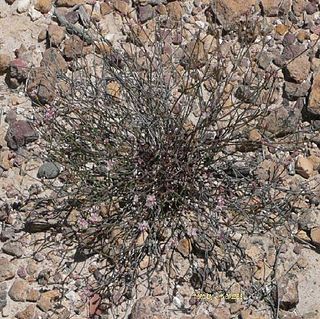
Eriogonum apricum is a rare species of wild buckwheat known by the common name Ione buckwheat. It is endemic to Amador County, California, in the United States.

Eriogonum arborescens is a species of wild buckwheat known by the common name Santa Cruz Island buckwheat.
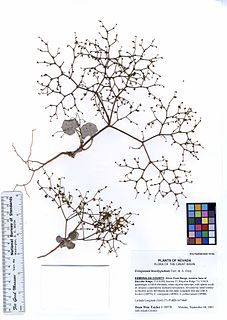
Eriogonum brachypodum is a species of wild buckwheat known by the common name Parry's buckwheat. This annual herb is native to the southwestern United States from California to Utah and especially the Mojave Desert. It grows in sandy and gravelly substrates. It has a skeletonlike spindly stem which branches many times. It can grow 5 to 50 centimeters in height and up to a meter in width. There is an array of rounded, dark-colored leaves around the base. Leaves are a few centimeters long and fuzzy on the undersides. Most of the plant is actually the spreading inflorescence. At intervals on the otherwise naked branches hang tiny clusters of glandular flowers a few millimeters wide in involucres of bell-shaped bracts. Each flower is less than three millimeters wide.
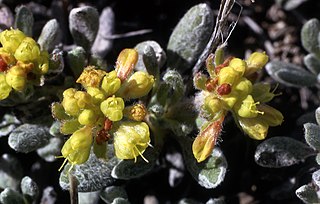
Eriogonum caespitosum is a species of wild buckwheat known by the common name matted buckwheat, mat buckwheat, or cushion desert buckwheat. It is a common perennial plant native to the western United States from California to Montana, especially the Great Basin. Flowering early in the summer, it is also cultivated as a rock garden plant.
Eriogonum dasyanthemum is a species of wild buckwheat known by the common name chaparral buckwheat. This plant is endemic to California where it is limited to the Northern Coast Ranges, but it is quite common in its native range.
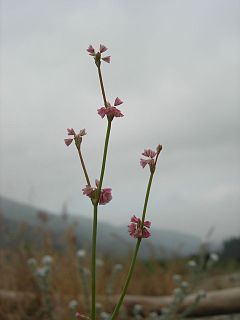
Eriogonum davidsonii is a species of wild buckwheat known by the common name Davidson's buckwheat. This plant is native to the southwestern United States and northern Baja California. It grows in sandy or gravelly soils, mixed grassland, saltbush, chaparral, sagebrush communities as well as oak and montane conifer woodland. It is a spindly annual herb growing up to 40 centimeters in height. Leaves are fuzzy, basal, and round with wavy or wrinkly margins fuzzy. They are two centimeters wide. The plant is variable in appearance, but is usually erect with thin, naked, neatly branching stems bearing clusters of tiny flowers at widely spaced nodes. Each flower is about 2 millimeters wide, bell-shaped, and can be white, pink or red. Flowering occurs May to September.

Eriogonum deflexum is a species of wild buckwheat known by the common names flatcrown buckwheat, flat-top buckwheat, and skeletonweed. This plant is native to the southwestern United States and northwestern Mexico, where it is common and grows in a variety of habitats, especially desert scrub. It is somewhat weedy where it is most abundant. This is an annual which varies in size from small patches on the ground to tangled bushes approaching two meters in height; it may be dense or thin and spindly. This is a brown or greenish weedy-looking herb with a many-branched stem. The leaves are located at the base of the plant and are rounded and woolly and one to four centimeters long. Small clusters of flowers appear at intervals along the branches with each flower only one to three millimeters wide and white or pinkish in color.

Eriogonum gracilipes is a species of wild buckwheat known by the common name White Mountains buckwheat.

Eriogonum hirtellum is a species of wild buckwheat known by the common name Klamath Mountain buckwheat. It is endemic to the Klamath Mountains of far northern California, where it is known from only a few occurrences.

Eriogonum lobbii is a species of wild buckwheat known by the common name Lobb's buckwheat or prostrate buckwheat. It is native to most of the mountain ranges of northern California and their extensions into Oregon and Nevada. It is found in a number of mountain plant communities.

Eriogonum saxatile is a species of wild buckwheat known by the common name hoary buckwheat. It is native to the dry, rocky mountain slopes of California and Nevada, where it is a common plant.

Eriogonum butterworthianum is a rare species of wild buckwheat known by the common name Butterworth's buckwheat. It is endemic to the Santa Lucia Mountains of central Monterey County, California, where it is known from a few occurrences in the wilderness southeast of Big Sur in the vicinity of Junipero Serra Peak. Its native habitats include oak and conifer woodlands, chaparral communities, and sandstone outcrops. Eriogonum butterworthianum is a small clumpy shrub or subshrub that grows up to about 30 centimeters tall and wide. Leaves are 2 centimeters long and reddish-green in color. They are woolly, oval in shape, and curled under at the edges. The inflorescence is a cluster of flowers up to 2 or 3 centimeters wide. Each individual flower is a few millimeters wide and dull yellowish to pinkish in color. Flowers bloom June to September.
Eriogonum pendulum is a rare species of wild buckwheat known by the common name Waldo buckwheat. It is endemic to the Klamath Mountains of Josephine County, Oregon, and Del Norte County, California, where it is a member of the serpentine soils flora.

Eriogonum siskiyouense is a rare species of wild buckwheat known by the common name Siskiyou buckwheat.
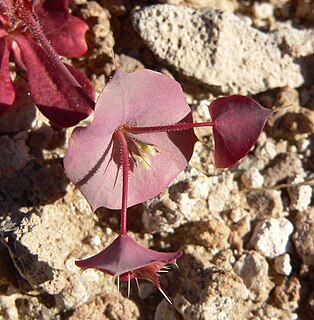
Oxytheca perfoliata is a species of flowering plant in the buckwheat family known by the common names round-leaf puncturebract and roundleaf oxytheca. It is native to the southwestern United States, where it is a common plant of the deserts and some woodland and valley areas. It is an annual herb producing a leafless stem up to about 20 centimeters in maximum height in the spring; during the winter the plant is a small rosette of oblong or spoon-shaped leaves a few centimeters wide. The plant is red-veined green, or often brown to maroon or magenta in color. The inflorescence atop the stem is punctuated by nodes at which the bracts are fused to form a cup or band up to about 2.5 centimeters wide. At the end of each branching of the stem is a similar cup of bracts partially fused around a cluster of flowers. The bracts are tipped in spinelike awns. The flowers are white to yellow-green and hairy in texture.

Eriogonum callistum is a rare species of wild buckwheat, known by the common name Tehachapi buckwheat.
Eriogonum cedrorum is a rare species of wild buckwheat known by the common name The Cedars buckwheat. It is endemic to Sonoma County, California where it is known only from The Cedars, an unincorporated area outside of Guerneville near Cazadero.
Eriogonum evanidum is a rare species of wild buckwheat known by the common name vanishing wild buckwheat. It is native to southern California and Baja California, where it has been collected from widely scattered areas. Most historical occurrences are now extirpated. Some sources suggested that it was probably extinct, but living specimens were rediscovered in 2007.

Eriogonum spectabile is a rare species of wild buckwheat known by the common name Barron's buckwheat. It is endemic to Plumas County, California, where it is known from two occurrences in Lassen National Forest near Chester. There are approximately 250 individuals in existence. It grows in scrubby, forested mountain habitat, only on glaciated andesite substrates. This rare plant was discovered in 1997 and described to science as a new species in 2001.















